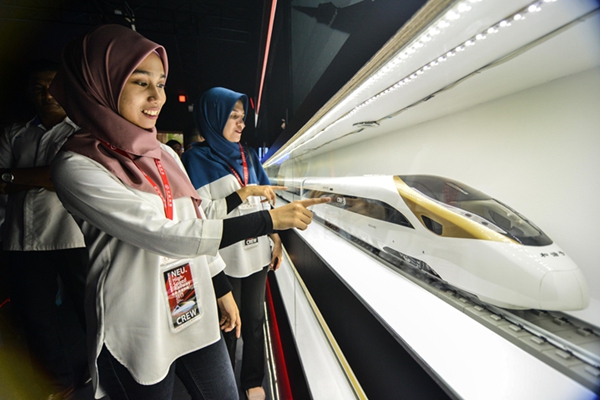Mixed ownership reform must first classify SOEs
- By Zhang Jingwei
 0 Comment(s)
0 Comment(s) Print
Print E-mail Beijing Review, February 6, 2017
E-mail Beijing Review, February 6, 2017
|
|
|
A model of China's bullet train on display at an exhibition on high-speed rail in Kuala Lumpur, Malaysia, on January 16. The exhibition was held by a Chinese consortium led by China Railway Corp. (XINHUA) |
Mixed ownership is the most significant issue in the ongoing reform of state-owned enterprises (SOEs). In order to fully unleash the benefits of the systematic SOE reform program and achieve positive outcomes, the government must first classify SOEs by function.
According to an Economic Information Daily report on January 11, notable progress has been made in such classification, which will be made public in the near future, and a corresponding assessment scheme has also been formulated. Consequently, mixed ownership reform based on SOE classification will accelerate.
According to Zhang Xiwu, Vice Minister of the National Development and Reform Commission, SOEs can be divided into two types: those that provide public goods and those that seek to attain commercial goals. Both types of SOEs are primarily independent market players, and they must follow market economy and corporate growth rules, serve the nation's development strategies and work for both economic and social benefits.
The two SOE types differ, however, in their development objectives. Commercially-oriented SOEs should aim to maintain state-owned assets and increase their market value, while publicly-oriented SOEs should focus on ensuring people's livelihoods and providing public products and services. After clarifying the development targets for each type, reform should follow a correspondingly appropriate path.
SOEs seeking commercial gain should implement thorough mixed ownership reform and establish a modern corporate structure by diversifying shareholding structure. The ownership of such SOEs will be arranged according to type. State-owned capital will retain majority control of SOEs engaged in national security or economic lifelines. SOEs in fully competitive industries should reduce stakes held by state-owned capital, adopt more open and diversified shareholding structures and enlisted in the stock market. SOEs holding industry monopolies must actively advance reform under the principles of dividing government functions from corporate management; promoting market-oriented allocation of public resources; and introducing other state-owned capital to enterprises that must be fully state-owned.
SOEs providing public benefits may be fully controlled by state capital, although a structure of diversified ownership can be adopted in some qualified enterprises. Non-state enterprises will also be encouraged to participate in such SOEs' business operations through means such as purchase of services and franchising.
Whether SOEs are commercially or publicly oriented, their status as market participants determines that they must fully engage in market competition both at home and abroad. Thus, openness and diversification of shareholding structures will become necessary.
Under fierce market competition, equality among players—SOEs, private firms and foreign-funded enterprises—will characterize market order, and securing advantages through status, privilege or policy will not work.
In accordance with the concepts of resource allocation by market forces and the rule of law, other types of capital must be allowed into SOEs in order to fully reform their makeup, inject vitality and thereby improve their competitiveness.
Classifying SOEs and subsequently implementing corresponding reforms, however, require careful consideration.
For instance, the definition of SOEs with commercial aims is clear. But, should the category include the three major telecom operators and state-owned commercial banks? In the mixed ownership reform, can they be changed from absolutely state-owned to majority state-owned or even joint-stock companies?
Moreover, how should important industries and key sectors concerning national security and economic lifelines be defined? Should SOEs such as China National Petroleum Corp., China National Offshore Oil Corp. and China Railway Corp. be included in this category? Although they must remain majority state-owned, while introducing private capital in their mixed ownership reform, the government should give private investors access to those good-quality resources to ensure their return on investment. Otherwise SOE reform will attract very little private capital, and mixed ownership reform will become empty talk.
Moreover, uncertainty still exists over the mixed ownership reform of SOEs with monopolies and in the definition of SOEs with public welfare aims.
Many SOEs possess both monopoly and publicly-oriented characteristics. China Railway Corp. is one such example. Therefore, many difficulties could be encountered when implementing mixed ownership reform in these enterprises. Monopolies must be broken by the reform, but the government must also ensure that such SOEs maintain their social service functions.
The author Zhang Jingwei is a researcher at the Charhar Institute, and this is an edited excerpt of an article originally published in National Business Daily







Go to Forum >>0 Comment(s)